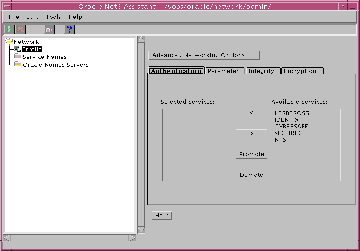Release 8.0
A58229-01
Library |
Product |
Contents |
Index |
| Oracle Advanced Networking Option Administrator's Guide Release 8.0 A58229-01 |
|
This chapter describes how to use conventional username/password authentication even if you have configured another authentication service. It also discusses how to configure your network to use one or more authentication services in your network using the Oracle Advanced Networking Option and how to set up more than one authentication service on a client or on a server.
Authentication adapters available with this release include the following:
Refer to the individual chapters and the platform-specific documentation listed above for details of configuring these adapters.
|
Note: Use the Oracle Net8 Assistant to edit client and server SQLNET.ORA files for CyberSAFE, Kerberos, SecurID, Biometric, and DCE GSSAPI adapters. |
To connect to an Oracle server using a username and password when an Oracle authentication adapter has been configured, you need to configure No Authentication in your profile (SQLNET.ORA). Use the Oracle Net8 Assistant to configure the profile (SQLNET.ORA).
Configure the profile for no authentication when you want to disable authentication. For example, for users to be able to log into an Oracle database server using username/password, you must disable authentication by defining this value. If you do, the profile appears as follows:
SQLNET.AUTHENTICATION_SERVICES = (NONE)
A user can now connect to a database using the following username/password format:
% sqlplus username/password@service_name
For example:
% sqlplus scott/tiger@emp
Refer to Figure 7-1, "Select No Authentication", for an example of how you use the Oracle Net8 Assistant to configure No Authentication. To configure No Authentication:

Many networks use more than one authentication service on a single security server. For this reason, the Oracle Advanced Networking Option allows you to configure your network so that Oracle clients can use a specific authentication service and Oracle Servers can accept any service specified.
This section describes how to set up an Oracle server that uses multiple authentication adapters. Depending on which authentication adapter the client is using, the server will pick one from the list of configured adapters. Following are examples of profiles (SQLNET.ORA) using multiple authentication adapters.
The profile for the Oracle server that uses either SecurID or CyberSAFE for authentication must contain the line:
SQLNET.AUTHENTICATION_SERVICES=(SECURID,CYBERSAFE)
The profile for the Oracle client that uses SecurID must contain the line:
SQLNET.AUTHENTICATION_SERVICES=(SECURID)
Using this configuration, the Oracle server will accept connections from clients using SecurID for the authentication service. This gives you flexibility in your network configuration.
The profile for the Oracle client that uses CyberSAFE must contain the line:
SQLNET.AUTHENTICATION_SERVICES=(CYBERSAFE)
Using this configuration, the Oracle server will accept connections from clients using CyberSAFE for the authentication service. This gives you flexibility in your network configuration.
This section describes how to set up clients to use multiple authentication adapters. Depending on which authentication adapter the server is configured to use, the client will pick one from the list of configured adapters. The following is an example of a profile using multiple authentication adapters.
The profile for the Oracle client that uses either SecurID or CyberSAFE for authentication must contain the line:
SQLNET.AUTHENTICATION_SERVICES=(SECURID,CYBERSAFE)
The profile for the Oracle server that uses SecurID to authenticate users must contain the line:
SQLNET.AUTHENTICATION_SERVICES=(SECURID)
The profile for the Oracle server that uses CyberSAFE to authenticate users must contain the line:
SQLNET.AUTHENTICATION_SERVICES=(CYBERSAFE)
Using this configuration, the Oracle client can connect to multiple Oracle servers using different authentication services.
You can use the Oracle Net8 Assistant to set up multiple authentication services on both client and server machines. Refer to Figure 7-2, "Set Up Multiple Authentication Services Using Oracle Net8 Assistant", for a sample Oracle Net8 Assistant window you use to set up multiple authentication services on clients and servers. The following instructions apply to both clients and servers.
